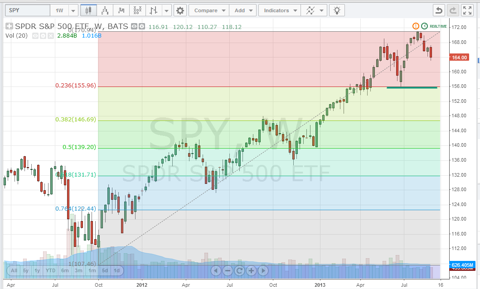At the point when Google dispatched the second cycle of the Nexus 7, it continued with Qualcomm's (QCOM) processor instead of sticking with Nvidia's (NVDA) Tegra 4. Nvidia lost a couple of smartphone slots such as HTC as well. What's more, Microsoft's (MSFT) Windows RT, which was based on the Tegra stage, never truly took off and Microsoft needed to suffer a gigantic record of $900 million.
This prompted an immense drop in sales of the Tegra and revenue from that segment dropped by 71% to $52.6 million in the second quarter. This headed me to state that investors should sell Nvidia shares.
Notwithstanding, there were numerous steps that Nvidia took to push the Tegra stage. One such exertion was the Nvidia SHIELD, a gaming handheld which won't be sufficient to turn its fortunes around. Be that as it may certain late developments show that there may be trust truth be told.
What next
It seems that Nvidia is attempting its hand at making a tablet. Regardless, its tablet will simply be known as the Tegra Tab. This will be an in-house item based on the 1.8ghz Tegra 4 processor and combined with 2gb of RAM. It will also presumably have a 7-creep 1280x768 display alongside what looks like front-confronting speakers and double cameras.
What's interesting is that it also comes with a stylus. This is supposed to be a demonstration of the Directstylus, the stylus engineering that Nvidia has created.
While it is still not clear what heading this exertion will take, yet in the event that Nvidia is going for gaming tablets, then it could make a separate market for itself, similar to the specialty PC gaming market which is developing despite declining PC sales.
An alternate critical slot that Nvidia has won for its Tegra stage is the Xiaomi smartphone. At the point when Xiaomi propelled the low end gadget called "Red Rice," it sold 100,000 units in 90 seconds. Xiaomi's Mi2 smartphone is directly behind the Galaxy S4 and HTC One in terms of sales.
Xiaomi made news when it figured out how to get Hugo Barra, the VP of Android item administration for Google, to go along with them so as to stretch globally. Presently, Xiaomi is just pander to three or four markets all inclusive.
What's most critical is that Xiaomi is as of now selling more than Apple in China. Just two years after its commencement, the organization plans to sell 15 million devices this year in China to net $4.5 billion in revenue. Miphone 3 offers decision of Tegra or Snapdragon processors. The Qualcomm Snapdragon 800 version is set to introduction with China Unicom and China Telecom while the Nvidia Tegra 4 model will dispatch with China Mobile.
This augurs well for Nvidia's Tegra stage because China Mobile is the world's largest telecom operator.
Furthermore, Asus stepped out recently with a Tegra 4-controlled top of the line high resolution tablet - Asus Transformer Pad Tf701t. This is first slate with a 1.9 Ghz Tegra 4 processor. It is asserted to be the world's fastest quad-center Cortex-A15 processor with a 72-center GPU.
Microsoft's second emphasis of the Surface Pro will also be based on the Tegra stage. Notwithstanding, vast scale acknowledgement of Surface tablets is yet to see the light of the day yet Microsoft has no decision yet to continue attempting till it succeeds as the PC market is in a decline.
Microsoft has sent out invites to the media for an occasion on Sept. 23, where it would presumably be refreshing the Surface tablet. The approaching Surface 2 is supposed to incorporate a two-stage kickstand, a 1080p display, and Nvidia's Tegra 4 processor, while Microsoft has chosen Intel's Haswell processor for the Surface 2 Pro.
So Tegra 4 is seeing more than just the light of the day now and slowly seems to be picking up slots in devices which may sell in nice numbers.
Past mobile registering
PC sales are declining yet this doesn't imply that everybody associated with the PC industry is damned. It's just the players who handle their exchange the wide based PC market that are feeling the high temperature. This includes all companies which sell low-end desktops and laptops to end users and will keep on being affected by the switch to tablets.
Be that as it may, the PC gaming market is stronger and companies like Nvidia which fundamentally coddle that segment require not be concerned much. The PC gaming market is still developing. Nvidia is focusing all the more on the top of the line PC gaming market and in the last reported quarter, GPU revenue increased 8% year-over-year, with strong interest for top of the line cards driving development.
Nvidia wins this one
Qualcomm is Nvidia's biggest risk. As specified prior, Qualcomm's Snapdragon displaced Nvidia from the Nexus tablet. What's more, the way that it as of now has a head start in 4g coordinated basebands while Nvidia is yet to bring the Tegra 4i to the market will make it more troublesome for Nvidia to addition customers.
Qualcomm has also been attempting to enter the high-volume market for smartphone processors in China as well. Yet it would appear that this round goes to Nvidia after it went into Xiaomi's telephone.
Conclusion
On the off chance that the moves that Nvidia is making to market and push the Tegra stage are successful, then its mobile figuring division should start seeing development. A ton depends on the sales of the Xiaomi Miphone 3 as future design wins of Nvidia in the Chinese market and its battle against Qualcomm may rely on upon it.
| Currently 0.00/512345 Rating: 0.0/5 (0 votes) |
More GuruFocus Links
| Latest Guru Picks | Value Strategies |
| Warren Buffett Portfolio | Ben Graham Net-Net |
| Real Time Picks | Buffett-Munger Screener |
| Aggregated Portfolio | Undervalued Predictable |
| ETFs, Options | Low P/S Companies |
| Insider Trends | 10-Year Financials |
| 52-Week Lows | Interactive Charts |
| Model Portfolios | DCF Calculator |
RSS Feed  | Monthly Newsletters |
| The All-In-One Screener | Portfolio Tracking Tool |
 MORE GURUFOCUS LINKS
MORE GURUFOCUS LINKS | Latest Guru Picks | Value Strategies |
| Warren Buffett Portfolio | Ben Graham Net-Net |
| Real Time Picks | Buffett-Munger Screener |
| Aggregated Portfolio | Undervalued Predictable |
| ETFs, Options | Low P/S Companies |
| Insider Trends | 10-Year Financials |
| 52-Week Lows | Interactive Charts |
| Model Portfolios | DCF Calculator |
RSS Feed  | Monthly Newsletters |
| The All-In-One Screener | Portfolio Tracking Tool |
 75.89 (1y: +20%) $(function(){var seriesOptions=[],yAxisOptions=[],name='QCOM',display='';Highcharts.setOptions({global:{useUTC:true}});var d=new Date();$current_day=d.getDay();if($current_day==5||$current_day==0||$current_day==6){day=4;}else{day=7;} seriesOptions[0]={id:name,animation:false,color:'#4572A7',lineWidth:1,name:name.toUpperCase()+' stock price',threshold:null,data:[[1374728400000,63.42],[1374814800000,64.61],[1375074000000,64.24],[1375160400000,64.51],[1375246800000,64.562],[1375333200000,65.27],[1375419600000,66.75],[1375678800000,66.25],[1375765200000,65.59],[1375851600000,65.21],[1375938000000,66.35],[1376024400000,66.27],[1376283600000,66.46],[1376370000000,67.25],[1376456400000,66.96],[1376542800000,66.95],[1376629200000,66.9],[1376888400000,66.33],[1376974800000,66.71],[1377061200000,66.57],[1377147600000,67.13],[1377234000000,67.15],[1377493200000,66.95],[1377579600000,66.021],[1377666000000,66.56],[1377752400000,66.71],[1377838800000,66.28],[1378184400000,66.75],[1378270800000,67.28],[1378357200000,67.83],[1378443600000,68.02],[1378702800000,69.299],[1378789200000,70.09],[1378875600000,68.09],[1378962000000,68.81],[1379048400000,68.58],[1379307600000,68.09],[1379394000000,69.42],[1379480400000,69.64],[1379566800000,69.46],[1379653200000,69.06],[1379912400000,68.98],[1379998800000,68.51],[1380085200000,68.75],[1380171600000,68.87],[1380258000000,67.38],[1380517200000,67.32],[1380603600000,67.49],[1380690000000,67.68],[1380776400000,67.11],[1380862800000,68.02],[1381122000000,67.19],[1381208400000,66.35],[1381294800000,65.71],[1381381200000,66.84],[1381467600000,67.55],[1381726800000,67.75],[1381813200000,68.17],[1381899600000,68.87],[1381986000000,68.7],[1382072400000,68.402],[1382331600000,68.77],[1382418000000,68.92],[1382504400000,67.04],[1382590800000,66.94],[1382677200000,68.27],[1382936400000,68.54],[1383022800000,68.93],[1383109200000,69.04],[1383195600000,69.49],[1383282000000,69.9],[1383544800000,69.57],[1383631200000,69.005],[1383717600000,69.74],[1383804000000,67.09],[1383890400000,67.45],[1384149600000,67.62],[1384236000000,68.51],[1384322400000,70.03],[1384408800000,71.22],[1384495200000,72.17],[1384754400000,71.94],[1384840800000,71.84],[1384927200000,71.03],[1385013600000,71.71],[1385100000000,72.96],[1385359200000,! 72.49],[1385445600000,73.65],[1385532000000,73.56],[1385704800000,73.58],[1385964000000,73.44],[1386050400000,73.31],[1386136800000,73.18],[1386223200000,73.23],[1386309600000,73.76],[1386568800000,73.37],[1386655200000,73.38],[1386741600000,73.01],[1386828000000,72.73],[1386914400000,72.58],[1387173600000,72.
75.89 (1y: +20%) $(function(){var seriesOptions=[],yAxisOptions=[],name='QCOM',display='';Highcharts.setOptions({global:{useUTC:true}});var d=new Date();$current_day=d.getDay();if($current_day==5||$current_day==0||$current_day==6){day=4;}else{day=7;} seriesOptions[0]={id:name,animation:false,color:'#4572A7',lineWidth:1,name:name.toUpperCase()+' stock price',threshold:null,data:[[1374728400000,63.42],[1374814800000,64.61],[1375074000000,64.24],[1375160400000,64.51],[1375246800000,64.562],[1375333200000,65.27],[1375419600000,66.75],[1375678800000,66.25],[1375765200000,65.59],[1375851600000,65.21],[1375938000000,66.35],[1376024400000,66.27],[1376283600000,66.46],[1376370000000,67.25],[1376456400000,66.96],[1376542800000,66.95],[1376629200000,66.9],[1376888400000,66.33],[1376974800000,66.71],[1377061200000,66.57],[1377147600000,67.13],[1377234000000,67.15],[1377493200000,66.95],[1377579600000,66.021],[1377666000000,66.56],[1377752400000,66.71],[1377838800000,66.28],[1378184400000,66.75],[1378270800000,67.28],[1378357200000,67.83],[1378443600000,68.02],[1378702800000,69.299],[1378789200000,70.09],[1378875600000,68.09],[1378962000000,68.81],[1379048400000,68.58],[1379307600000,68.09],[1379394000000,69.42],[1379480400000,69.64],[1379566800000,69.46],[1379653200000,69.06],[1379912400000,68.98],[1379998800000,68.51],[1380085200000,68.75],[1380171600000,68.87],[1380258000000,67.38],[1380517200000,67.32],[1380603600000,67.49],[1380690000000,67.68],[1380776400000,67.11],[1380862800000,68.02],[1381122000000,67.19],[1381208400000,66.35],[1381294800000,65.71],[1381381200000,66.84],[1381467600000,67.55],[1381726800000,67.75],[1381813200000,68.17],[1381899600000,68.87],[1381986000000,68.7],[1382072400000,68.402],[1382331600000,68.77],[1382418000000,68.92],[1382504400000,67.04],[1382590800000,66.94],[1382677200000,68.27],[1382936400000,68.54],[1383022800000,68.93],[1383109200000,69.04],[1383195600000,69.49],[1383282000000,69.9],[1383544800000,69.57],[1383631200000,69.005],[1383717600000,69.74],[1383804000000,67.09],[1383890400000,67.45],[1384149600000,67.62],[1384236000000,68.51],[1384322400000,70.03],[1384408800000,71.22],[1384495200000,72.17],[1384754400000,71.94],[1384840800000,71.84],[1384927200000,71.03],[1385013600000,71.71],[1385100000000,72.96],[1385359200000,! 72.49],[1385445600000,73.65],[1385532000000,73.56],[1385704800000,73.58],[1385964000000,73.44],[1386050400000,73.31],[1386136800000,73.18],[1386223200000,73.23],[1386309600000,73.76],[1386568800000,73.37],[1386655200000,73.38],[1386741600000,73.01],[1386828000000,72.73],[1386914400000,72.58],[1387173600000,72.
 When to get codes
When to get codes  Associated Press
Associated Press  Bloomberg News
Bloomberg News 



 Solar Roadways/APInventors Scott and Julie Brusaw stand for a photo on a prototype solar-panel parking area at their company's business in Sandpoint, Idaho. SPOKANE, Wash. -- The solar panels that Idaho inventor Scott Brusaw has built aren't meant for rooftops. They are meant for roads, driveways, parking lots, bike trails and, eventually, highways. Brusaw, an electrical engineer, says the hexagon-shaped panels can withstand the wear and tear that comes from inclement weather and vehicles, big and small, to generate electricity. "We need to rebuild our infrastructure," said Brusaw, the head of Solar Roadways, based in Sandpoint, Idaho, about 90 miles northeast of Spokane, Washington. His idea contains "something for everyone to like." "Environmentalists like it," he said. "Climate change deniers like it because it creates jobs." While the idea may sound outlandish to some, it has already got $850,000 in seed money from the federal government, raised more than $2 million on a crowd-funding website and received celebrity praise. Solar Roadways is part of a larger movement that seeks to integrate renewable energy technology -- including wind, geothermal and hydro power -- seamlessly into society. The Solar Energy Industries Association, a trade group based in Washington, D.C., described companies like Solar Roadways as "niche markets" in the booming alternative energy industry. "They represent the type of creative innovation that addresses design and energy, while showcasing the diversity of solar applications," said Tom Kimbis, a vice president of the association. Brusaw said that in addition to producing energy, the solar panels can melt away snow and ice, and display warning messages or traffic lines with LED lights. There are skeptics, who wonder about the durability of the panels, which are covered by knobby, tempered glass, and how they would perform in severe weather or were covered with dirt. "It seems like something reasonable and something that is going to be very expensive," said Lamar Evans of the National Renewable Energy Association in Hattiesburg, Mississippi. Another problem would be how to store the electricity that could be generated, Evans said. The Brusaws have produced no estimates of how much the solar panels would cost, so the financial realities of their vision remain an unknown. To demonstrate the concept, the company has created a small parking lot at its headquarters, using 108 solar panels. Vehicles have been driven onto the space, without damaging the panels, he said. "We'll start off small with driveways and walkways," he said. His wife Julie came up with the idea after watching "An Inconvenient Truth," the global warming movie featuring former Vice President Al Gore, Brusaw said. She remembered that Scott had long talked about the concept of electric roads. The U.S. Federal Highway Administration gave the Brusaws $850,000 to develop Solar Roadways over the past few years, and build the prototype parking lot. This year, they turned to the Indiegogo crowd-funding site to raise additional money and move to the next phase. Launched on Earth Day, the campaign got off to a discouraging start, Brusaw said. Donations trickled in slowly, but two factors helped spread the company's vision: a viral YouTube video and celebrity mentions in social media. The video has more than 14 million views. The floodgates opened when actor George Takei of "Star Trek" fame and the TV show "MythBusters" mentioned the company. They received donations from more than 45,000 people in 50 countries. The money will enable the company to hire staff and begin production of more panels, Brusaw said. "Once we've perfected everything, our ultimate goal will be highways," he said.
Solar Roadways/APInventors Scott and Julie Brusaw stand for a photo on a prototype solar-panel parking area at their company's business in Sandpoint, Idaho. SPOKANE, Wash. -- The solar panels that Idaho inventor Scott Brusaw has built aren't meant for rooftops. They are meant for roads, driveways, parking lots, bike trails and, eventually, highways. Brusaw, an electrical engineer, says the hexagon-shaped panels can withstand the wear and tear that comes from inclement weather and vehicles, big and small, to generate electricity. "We need to rebuild our infrastructure," said Brusaw, the head of Solar Roadways, based in Sandpoint, Idaho, about 90 miles northeast of Spokane, Washington. His idea contains "something for everyone to like." "Environmentalists like it," he said. "Climate change deniers like it because it creates jobs." While the idea may sound outlandish to some, it has already got $850,000 in seed money from the federal government, raised more than $2 million on a crowd-funding website and received celebrity praise. Solar Roadways is part of a larger movement that seeks to integrate renewable energy technology -- including wind, geothermal and hydro power -- seamlessly into society. The Solar Energy Industries Association, a trade group based in Washington, D.C., described companies like Solar Roadways as "niche markets" in the booming alternative energy industry. "They represent the type of creative innovation that addresses design and energy, while showcasing the diversity of solar applications," said Tom Kimbis, a vice president of the association. Brusaw said that in addition to producing energy, the solar panels can melt away snow and ice, and display warning messages or traffic lines with LED lights. There are skeptics, who wonder about the durability of the panels, which are covered by knobby, tempered glass, and how they would perform in severe weather or were covered with dirt. "It seems like something reasonable and something that is going to be very expensive," said Lamar Evans of the National Renewable Energy Association in Hattiesburg, Mississippi. Another problem would be how to store the electricity that could be generated, Evans said. The Brusaws have produced no estimates of how much the solar panels would cost, so the financial realities of their vision remain an unknown. To demonstrate the concept, the company has created a small parking lot at its headquarters, using 108 solar panels. Vehicles have been driven onto the space, without damaging the panels, he said. "We'll start off small with driveways and walkways," he said. His wife Julie came up with the idea after watching "An Inconvenient Truth," the global warming movie featuring former Vice President Al Gore, Brusaw said. She remembered that Scott had long talked about the concept of electric roads. The U.S. Federal Highway Administration gave the Brusaws $850,000 to develop Solar Roadways over the past few years, and build the prototype parking lot. This year, they turned to the Indiegogo crowd-funding site to raise additional money and move to the next phase. Launched on Earth Day, the campaign got off to a discouraging start, Brusaw said. Donations trickled in slowly, but two factors helped spread the company's vision: a viral YouTube video and celebrity mentions in social media. The video has more than 14 million views. The floodgates opened when actor George Takei of "Star Trek" fame and the TV show "MythBusters" mentioned the company. They received donations from more than 45,000 people in 50 countries. The money will enable the company to hire staff and begin production of more panels, Brusaw said. "Once we've perfected everything, our ultimate goal will be highways," he said.
 Associated Press
Associated Press 

 Popular Posts: Hottest Technology Stocks Now – IGTE GTAT PRLB BBRYHottest Healthcare Stocks Now – MNKD INO ACAD INCY8 Biotechnology Stocks to Buy Now Recent Posts: 9 Oil and Gas Stocks to Buy Now 7 Internet and Web Service Stocks to Buy Now 15 Oil and Gas Stocks to Sell Now View All Posts 15 Oil and Gas Stocks to Sell Now
Popular Posts: Hottest Technology Stocks Now – IGTE GTAT PRLB BBRYHottest Healthcare Stocks Now – MNKD INO ACAD INCY8 Biotechnology Stocks to Buy Now Recent Posts: 9 Oil and Gas Stocks to Buy Now 7 Internet and Web Service Stocks to Buy Now 15 Oil and Gas Stocks to Sell Now View All Posts 15 Oil and Gas Stocks to Sell Now  Related ISCA Stocks To Watch For July 3, 2014 Top 4 Stocks In The Sporting Activities Industry With The Highest EPS
Related ISCA Stocks To Watch For July 3, 2014 Top 4 Stocks In The Sporting Activities Industry With The Highest EPS  Target: No guns in our stores, please NEW YORK (CNNMoney) If you're heading to Target, leave your guns at home.
Target: No guns in our stores, please NEW YORK (CNNMoney) If you're heading to Target, leave your guns at home. 